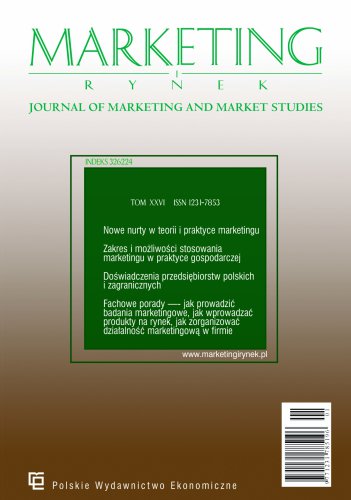Lateral food products and shaping of their image — a model approach
This article deals with the subject of lateral marketing as a method of creating new products in the context of shaping the image of food products. The article is theoretical and empirical. This article presents the theoretical model of using lateral marketing activities in the process of shaping the image of food products which was empirically verified later in the article. The purpose of this article was to define the importance of creating of lateral products in the perception of food products by final buyers.
References
Bibliografia/References
Barrena, R. i Sanchez, M. (2010). Frequency of consumption and changing determinants of purchase decisions: from attributes to values in the organic food market. Spanish Journal of Agricultural Research, (2). https://doi.org/10.5424/sjar/2010082-1178
Baruk, A. I. (2008). Postmodernistyczne koncepcje marketingowe a marketing klasyczny. Toruń: Wydawnictwo „Dom Organizatora”.
Białoskurski, S. i Wojcieszek, M. (2015). Marketing lateralny w kształtowaniu wizerunku nowych produktów spożywczych. „Marketing przy Kawie”. http://www.marketing-news.pl/theme.php?art=1924 (20.11.2019.).
Boratyńska-Sala, A. (2014). Techniki stymulujące kreatywność. W: R. Knosala (red.), Zarządzanie innowacjami. Warszawa: Polskie Wydawnictwo Ekonomiczne.
Chunhui Huoa, Javaria Hameeda, Inzamam Ul Haqb, Sohail M. Nomanc i Sohail Raza Chohand. (2020). The Impact of Artificial and Non-Artificial Intelligence on Production and Operation of new Products-An Emerging Market Analysis of Technological Advancements. A Managerial Perspective. Revista Argentina de Clinica Psicologica, XXIX(5), 69–82.
Ćwiklińska, J. (2012). Podejmowanie i prowadzenie działalności gospodarczej w turystyce. Część II — Relacje z otoczeniem. Warszawa: Wydawnictwo SGH.
de Bono, E. (1968). Lateral Thinking. http://www.edwdebono.com/lateral.htm (14.04.2019).
Dziadkiewicz, A. (2018). Koncepcja rozwoju nowego produktu a dyfuzja innowacji. Zarządzanie i Finanse, 16(3).
Guerrero, L., Guardia, M. D., Xicola, J., Verbeke, W., Vanhonacker, F., Żakowska-Biemans, S., Sajdakowska, M., Sulmont-Rosse, C., Issanchou, S., Contel, M., Scalvedi, M. L., Signe Granli, B. i Hersleth, M. (2009). Consumer-driven definition of traditional food products and innovation in traditional foods. A qualitative cross-cultural study, Appetite, 52(2). http://www.sciencedirect.com/science?_ob=ArticleURL&_udi=B6WB2-4V0TCX5-1&_user=3033937&_coverDate=04%2F30%2F2009&_rdoc=1&_fmt=high&_orig=gateway&_origin=gateway&_sort=d&_docanchor=&view=c&_searchStrId=1678098826&_rerunOrigin=scholar.google&_acct=C000059495&_version=1&_urlVersion=0&_userid=3033937&md5=802d843cc7e-01625ff5690bfaeb57698&searchtype=a
Kotler, Ph. (2005). Marketing. Poznań: Dom Wydawniczy Rebis.
Kotler, Ph. i Trias de Bes, F. (2003). Lateral Marketing: New Techniques for Finding Breakthrough Ideas. New Jersey: John Wiley & Sons.
Kotler Ph. i Trias de Bes, F. (2004). Marketing lateralny. Warszawa: Polskie Wydawnictwo Ekonomiczne.
Kusińska, A. (2014). Segmentacja rynku i marketing lateralny jako czynniki kreatywnego zarządzania produktem. Marketing i Rynek, (8), 510–516.
Ledwith, A. i O'Dwyer, M. (2008). Product launch, product advantage and market orientation in SMEs. Journal of Small Business and Enterprise Development, 15 Issues 1, 96–110. https://doi.org/10.1108/14626000810850865
Lv, H. (2008). Research on Corporate Image Orientation. Asian Social Science, 4(5). https://doi.org/10.5539/ass.v4n5p18
Mruk, H., (2012). Marketing. Satysfakcja klienta i rozwój przedsiębiorstwa. Warszawa: Wydawnictwo Naukowe PWN.
Niestrój, R. (1999). Zarządzanie marketingiem. Aspekty strategiczne. Warszawa–Kraków: Wydawnictwo Naukowe PWN.
Orfin K. i Sidorkiewicz, M. (2016). Rola wizerunku krajowego produktu turystycznego w kreowaniu ruchu turystycznego. Studium przypadku na przykładzie Polski i Łotwy. Ekonomiczne Problemy Turystyki, 35(3).
Predić, B. (1998). Strategic production management in enterprise. Economics and Organization, 1(6).
Ries, A. i Trout, J. (2000). 22 niezmienne prawa marketingu. Warszawa: Polskie Wydawnictwo Ekonomiczne.
Schulz, M. (2011). Segmentacja i pozycjonowanie produktu. W: K. Andruszkiewicz (red.), Marketing. Toruń: Wydawnictwo „Dom Organizatora”.
Sen Sharma, S. The product is king in lateral marketing, http://www.marketingcrossing.com/article/220033/The-Product-is-King-in-Lateral-Marketing/ (16.04.2019).
Stecz, W. i Pytlak, R.(2016). Launching new it product into the market. Research in Logistic & Production, 6(1), 89–102. https://doi.org/10.21008/j.2083-4950.2016.6.1.9
Stevanovski, M. (2011). Lateral marketing and its application in the foods market. Journal of Hygienic Engineering and Design.
Szwajca, D. (2011). Marketing lateralny jako alternatywna metoda generowania idei nowych produktów. Politechnika Śląska, Wydział Organizacji i Zarządzania, Instytut Ekonomii i Informatyki.
Trias de Bes, F. i Kotler, Ph. (2013). Innowacyjność. Przepis na sukces. Model „od A do F”. Poznań: Dom Wydawniczy Rebis.
Urbaniak, M. (2003). Wizerunek dostawcy na rynku dóbr produkcyjnych. Łódź: Wydawnictwo Uniwersytetu Łódzkiego.

